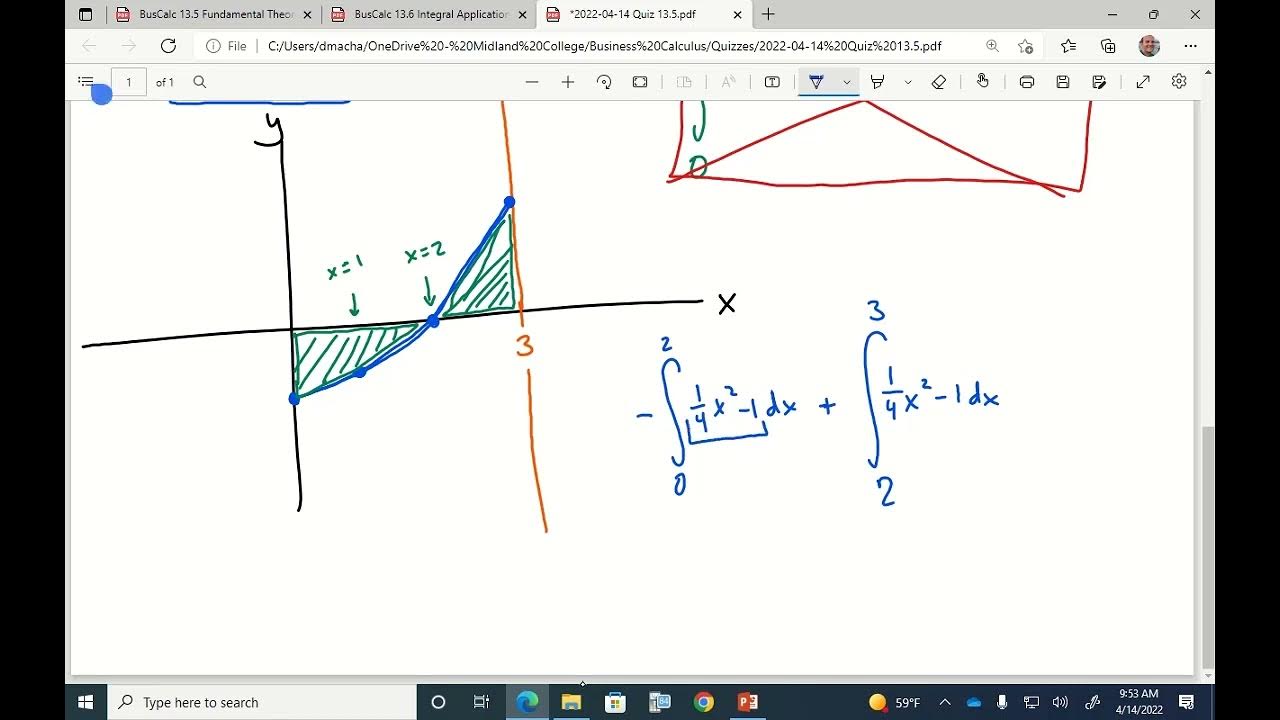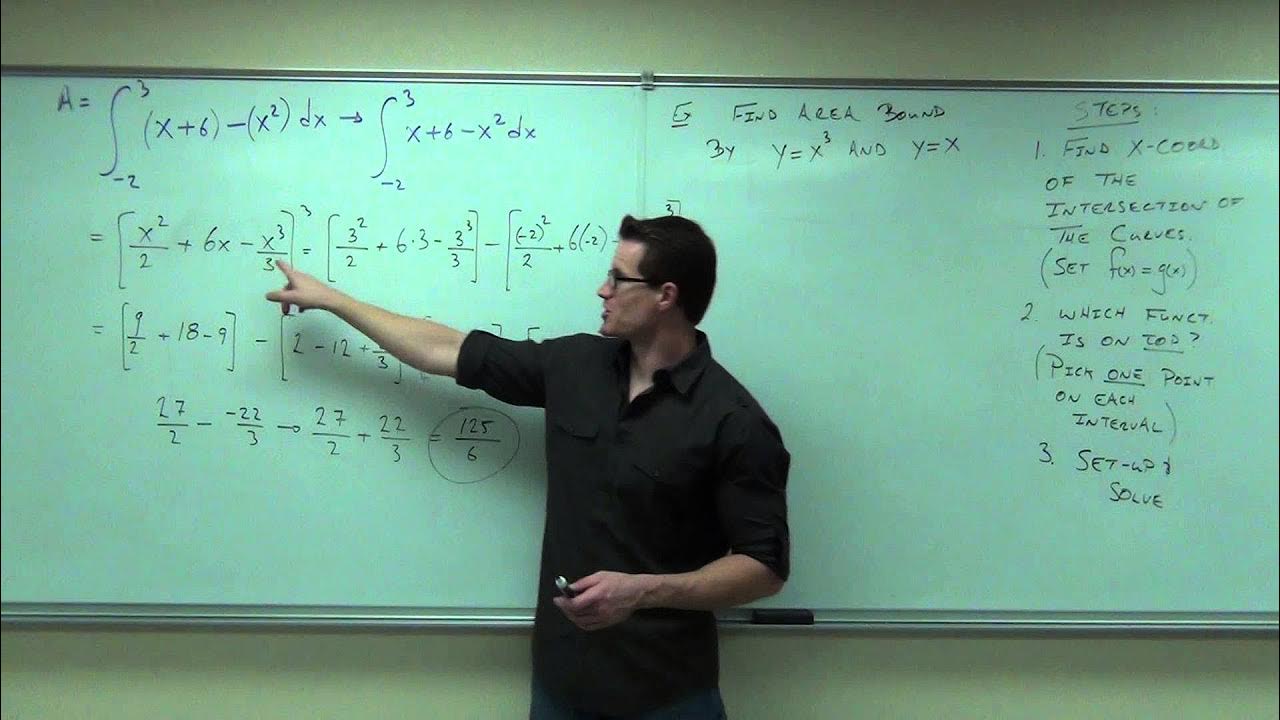Calculus Rhapsody
TLDRThe transcript appears to be a casual and informal discussion about various concepts in calculus, including continuity, limits, derivatives, and integrals. The speaker seems to be reflecting on their learning experience and the application of these mathematical concepts, such as finding areas under curves and differentiating equations. The conversation takes a light-hearted turn with the mention of 'dance' and 'whipped cream,' suggesting an attempt to make the complex subject matter more enjoyable. The speaker concludes by expressing satisfaction with their comprehensive review of the topic.
Takeaways
- 📚 The script discusses various concepts in calculus, including continuity, limits, derivatives, and integrals.
- 🎶 There is a humorous mention of singing about calculus topics, indicating a lighthearted approach to learning.
- 🤔 The concept of finding areas between curves is mentioned, which relates to integration.
- 💃 A dance metaphor is used to remember the process of finding areas under curves, emphasizing the importance of the integration process.
- 🚫 The script touches on the idea that forgetting steps (or processes) can lead to incorrect results.
- 🌟 The mention of 'x equals' suggests the beginning of an equation or problem-solving approach.
- 🍰 A whimsical reference to whipped cream on the y-axis highlights the creative ways to visualize mathematical concepts.
- 🏆 The concept of limits and infinity is briefly introduced, likely in the context of limit processes.
- 📈 The script implies that understanding differentiability is crucial for working with equations in calculus.
- 🛤️ There is an expression of satisfaction with the phrase 'that was fun yeah,' indicating an enjoyable learning experience.
- 🎓 The final statement 'oh' suggests a sense of accomplishment or realization that the entire topic has been covered.
Q & A
What does it mean when the script asks if a function 'f' is continuous?
-In mathematics, asking if a function 'f' is continuous means checking whether there are any breaks, jumps, or points of discontinuity in its graph. A function is continuous at a point if the limit at that point equals the function's value there.
How is the limit process used to determine continuity?
-The limit process helps determine continuity by calculating the function's limit as it approaches a certain point from both directions. If these limits are equal and match the function's value at that point, the function is continuous there.
Why does the script mention no sharp points or asymptotes in relation to a function?
-Mentioning no sharp points or asymptotes suggests characteristics of a smooth curve, indicative of a continuous and differentiable function. Sharp points could imply corners or cusps, and asymptotes suggest behavior where the function heads towards infinity, both complicating continuity and differentiability.
What are derivatives and integrals as referred to in the script?
-Derivatives represent the rate of change of a function, useful for understanding slopes and tangents on graphs. Integrals, on the other hand, represent the accumulation of values, useful for calculating areas under curves, among other things.
How can you find the area between two curves?
-The area between two curves can be calculated by integrating the difference of their respective functions over a given interval. The integral of the top function minus the bottom function over the interval gives the enclosed area.
What does it imply when the script discusses 'multiplying by the change' in a mathematical context?
-Multiplying by the change likely refers to calculating differential quantities in calculus, such as using small increments or decrements (deltas) in variables to approximate changes in function values, integral sums, or in derivative calculations.
What is meant by 'integration' and how is it related to 'area under curve'?
-Integration is a fundamental concept in calculus used to compute the area under a curve. By integrating a function over a specified interval, you sum up infinitesimally small areas to find the total area between the curve and the x-axis.
How does the script link the concepts of limits, infinity, and differentiation?
-The script connects these concepts as fundamental tools in calculus. Limits involve approaching a point or infinity in function evaluation, differentiation relates to calculating derivatives or rates of change, and both are critical for analyzing function behaviors at boundaries and infinities.
Why does the script personify mathematical concepts like 'nobody loves me' for y-axis?
-This personification adds a humorous or memorable touch to the learning material, making abstract concepts more relatable and easier to remember. It creatively engages students by humanizing the y-axis, often used in integration and as a reference in plots.
What is the significance of saying 'any mere equation, it is differentiable, for me'?
-This phrase highlights the notion that many basic equations in calculus are differentiable, meaning their derivatives exist. This simplifies many calculus problems and is a cornerstone for understanding changes and rates within those equations.
Outlines
📚 Introduction to Calculus Concepts
This paragraph delves into the foundational concepts of calculus, touching upon continuity, limits, derivatives, and integrals. The speaker expresses a sense of accomplishment and familiarity with these mathematical ideas, indicating a solid understanding of the subject matter. The paragraph begins with a casual inquiry about the nature of a function being discussed, transitioning into a more structured exploration of calculus techniques. The mention of finding areas between curves and the equation 'x equals' suggests an application of integral calculus, specifically the use of the fundamental theorem of calculus to calculate definite integrals. The paragraph concludes with a playful reference to a 'dance', possibly indicating a mnemonic or ritual associated with problem-solving in calculus.
🎶 The Joy of Understanding Differentiation
The second paragraph takes on a more reflective and appreciative tone, as the speaker acknowledges the beauty and challenge of differentiable equations. The paragraph conveys a sense of satisfaction and accomplishment in mastering the craft of calculus, with a particular focus on differentiation. The speaker's enthusiasm is evident, as they express that the session was enjoyable and that they believe they have covered the entire topic comprehensively. The paragraph ends on a light-hearted note, suggesting a positive and engaging learning experience.
Mindmap
Keywords
💡calculus
💡continuous function
💡limit process
💡differentiation
💡integrals
💡area under a curve
💡asymptotes
💡change
💡y-axis
💡equation
💡differentiable
Highlights
Discussion on the concept of continuity in functions and its importance in calculus.
Mention of the limit process as a fundamental tool in calculus for understanding functions' behavior.
Identification of functions without sharp points or asymptotes as being continuous.
Reference to the vast knowledge in calculus, including various techniques and concepts.
The application of calculus in finding derivatives, which is crucial for analyzing functions' rates of change.
Integration as a method to calculate areas between curves, providing practical applications in various fields.
The importance of the area under a curve, which can be found using integration.
The use of the 'dance' as a metaphor for the process of solving calculus problems, emphasizing the need for a methodical approach.
The concept of change as a central theme in calculus, particularly in the context of finding derivatives.
The mention of 'whipped cream' as a metaphor for the y-axis, illustrating the application of calculus in a fun and engaging way.
The idea of finding limits as a key aspect of understanding the behavior of functions at their extremes.
Differentiation as a powerful tool for analyzing and solving equations.
The notion that any mere equation can be differentiable, showcasing the versatility of calculus.
The overall enjoyment and satisfaction derived from engaging with calculus and its concepts.
The sense of accomplishment from completing a comprehensive exploration of calculus topics.
Transcripts
Browse More Related Video
5.0 / 5 (0 votes)
Thanks for rating:





